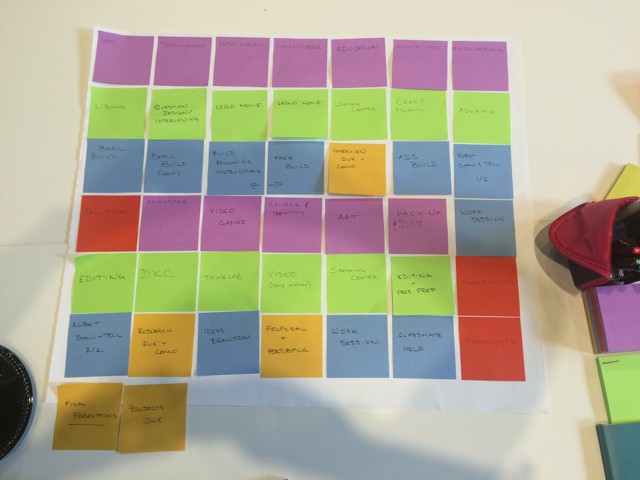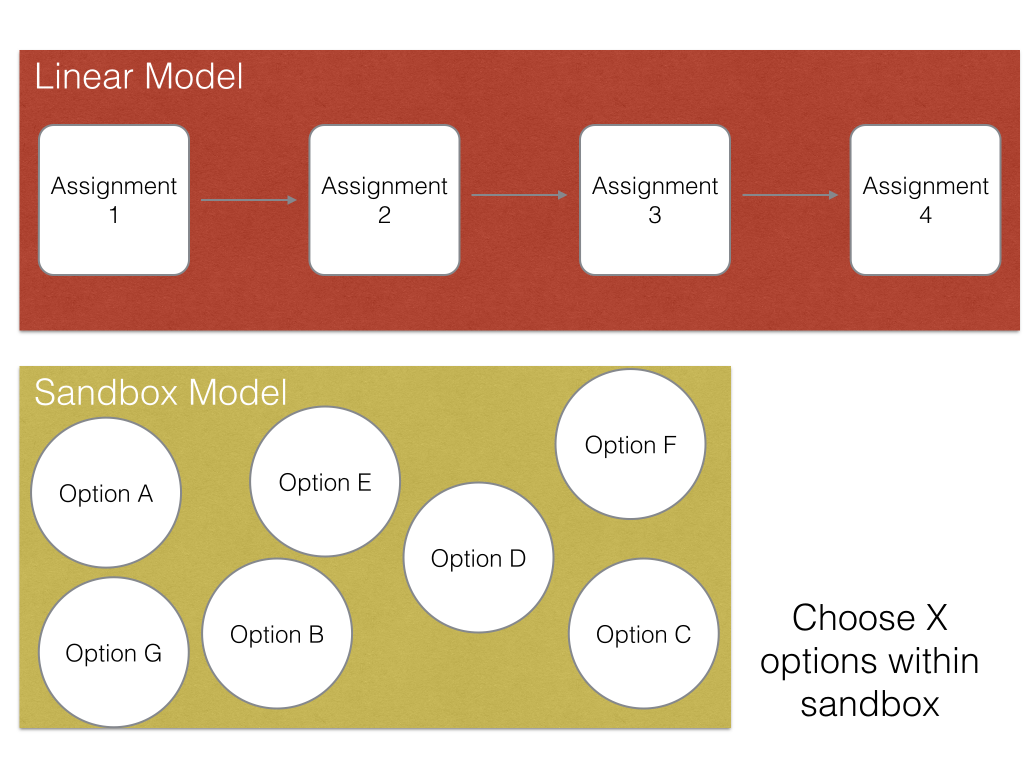Over the past 18 months or so I’ve methodically worked up to my new LEGO FSEM. I started with just the idea and then went forward with everything I’ve mentioned in the “building a syllabus” series: figuring out topics, researching literature, developing assignments… The added wrinkle this time around was making sure I had the LEGO needed to make the class happen. So lots of planning ahead, and lots of methodical steps. And then two weeks ago I kind of exploded the whole thing.

Two weeks ago I participated in the “Questing Course Content” game camp held by CTE&I. I’ve previously done a bit with gamification – and co-led Game Camp in the past – but this time I was just another person there to learn. As part of the event, we discussed different assignment types, which can be roughly divided as linear and “sandbox”. Personally, I’ve only ever assigned linear assignments. In most fields, this is the more practical approach: as you learn things, you apply them, and often this means assignments can also build upon each other. But sandboxing is kind of neat: it allows for a great deal of creativity within limited bounds. As its name implies, in a sandbox system, students get to choose which assignments they want to tackle, and can work on them in any order.

Halfway through Game Camp I thought I had my schedule completely set up, with traditional linear assignments. And then I changed my mind. As I said, it’s not every day I can teach sandbox style. Usually there’s a progression that’s unavoidable. But with this LEGO FSEM, I have an uncommon degree of freedom. Why not take advantage of it and widen my teaching abilities? So, BOOM. My carefully constructed schedule was demolished as I worked around the new assignments.
What is becoming clear as I work through this is that (1) a linear schedule doesn’t work well at all with sandbox assignments and (2) working out assignments is much, much more challenging.
1- I guess I should not be surprised. The linear approach means not just that the assignments build upon the course as it progresses but also that timelines can vary. For instance, smaller assignments at the beginning of the semester can be closer together, while the big final project(s) will have much more time. This doesn’t work at all with sandboxing. Instead, the time for assignments has to be either equivalent for each assignment or just… Not there. I know some courses that just require X assignments due by the end of the semester. That sounds fine for an advanced student, but not for a first semester college student. So instead I divided the semester into 4 week quarters, with one assignment due at the end of each. That way, students hopefully can’t fall behind. But of course changing the assignment timing is like knocking over a domino. I had previously scheduled lectures/discussions to build to assignments. With the sandboxing, that doesn’t work. Instead, I need to think of a clear intro to ALL THE ASSIGNMENTS at the beginning and then a modular approach for the rest of the semester, with plenty of time for in-class work, critiques, presentations, and feedback.
2- Again, I should have anticipated that sandboxing requires very well defined assignments. I kind of did, and both Mary and Seann emphasized the importance of creating clear boundaries of the sandbox. But still, the balancing act is daunting. Think about it: all the assignments have to be very clearly defined, have to be equivalent to other assignments (since students will only do some of them), have to collectively – but in different combinations – cover all the instructor thinks is important, and HAVE to be ready before the semester starts. There can’t be any course correction or improvising once the semester starts. Or I should say the students should be able to be creative within the sandbox, but if any assignment is poorly thought-out, that’s on the professor, and it won’t be fixable until the next iteration of the course.
I still have no idea how all of this will turn out. For one, while I have most assignments roughly figured out, i haven’t written out the instructions. For another, I still have to re-fit all the readings and tweak the schedule a bit more. Finally: I’ve never done this before. So for all I know it will be a spectacular disaster. But it’s exciting, and how often can people say that about syllabus building?


Very interested to hear more, esp. as the mashup of a modular approach and Lego theme has me imagining Gamera entering the scene to meet Godzilla. Seriously, I’m intrigued by the frame here — and Lego as a metaphor. A box of bricks (sorted or not) that active participants can arrange in their own order for the course, with some rules at hand, but not a strict one-way diagram to follow. Build this… or try that. Sounds like the processes of deciding order and discussing those decisions are empowering in themselves… as would be a consideration of the fundamentals that come within the assignments. What of a wild-card assignment that might be itself student-designed to add to the mix? Matched with a piece in which the rationale or logics need also to be articulated? Playing here with some random bricks…
Great to see you post again! (I really should myself.) You planning sounds cool and exciting, if a bit nerve-wracking. Keep us posted how it’s going, and feel free to ask the internet for help.